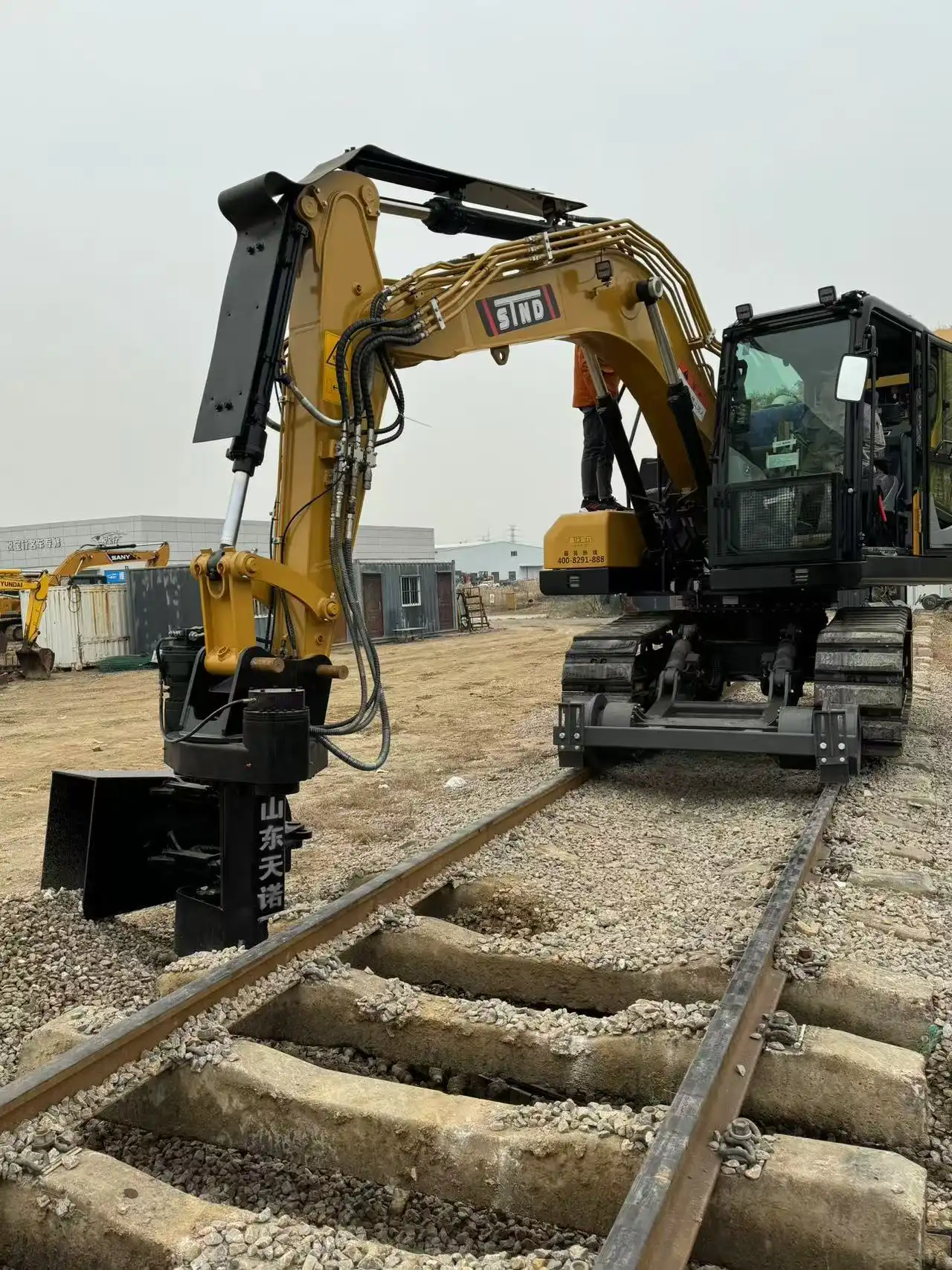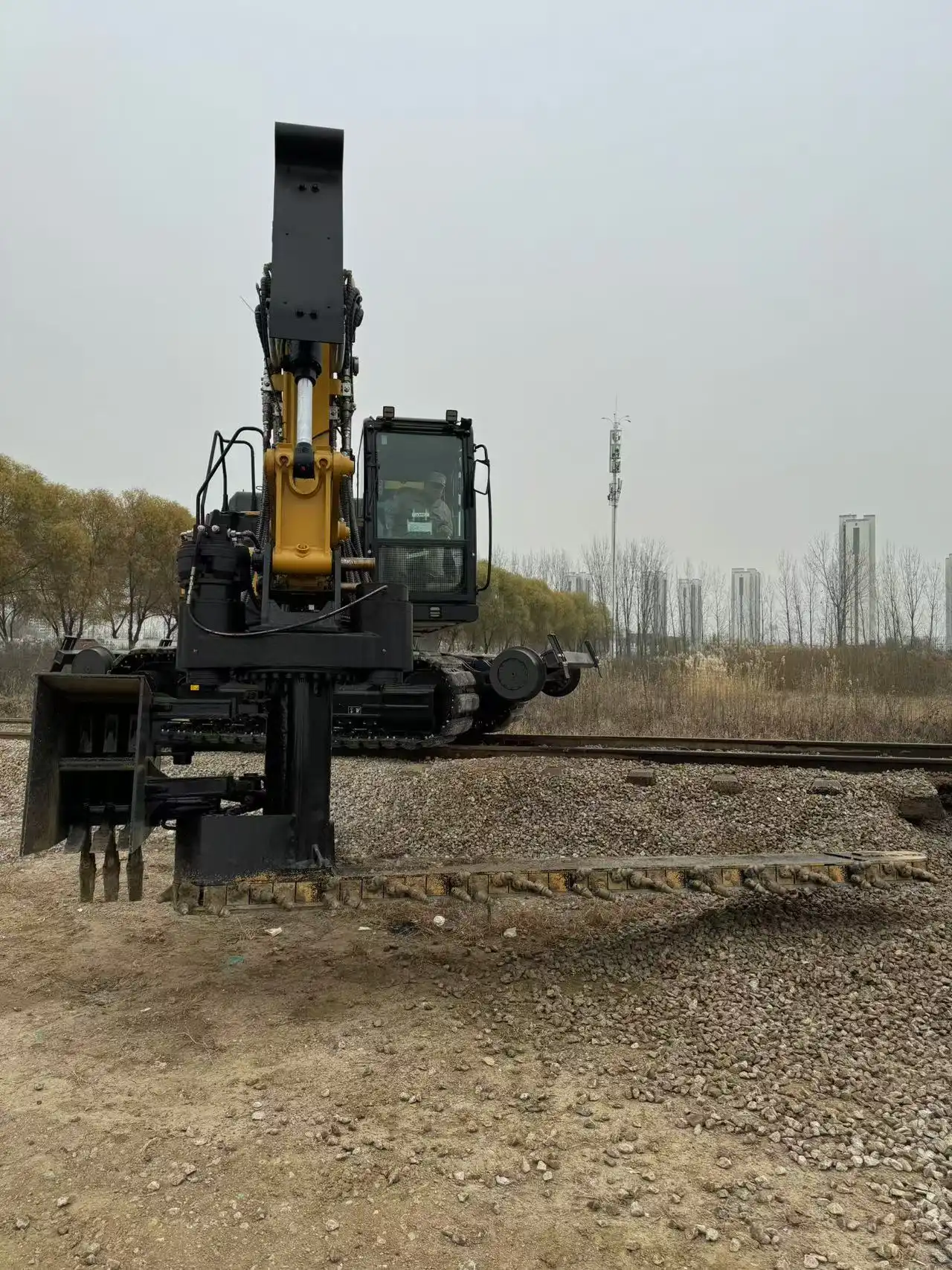What’s the difference between a ballast cleaner and a ballast undercutter?
The primary difference between a ballast cleaner and a ballast undercutter lies in their operational methodology and specific applications within railway maintenance. While both machines serve the crucial purpose of maintaining track ballast quality, ballast cleaners focus on screening and separating contaminated material from reusable ballast through sophisticated screening systems, whereas ballast undercutters excel at removing fouled ballast from beneath railway tracks using cutting chains and extraction mechanisms. A rail-road ballast undercutter excavator specifically targets hard-to-reach areas under rails, cutting through compacted material with precision undercutting bars that can reach depths up to 800mm. Understanding these distinctions becomes essential for railway maintenance professionals who need to select the appropriate equipment for specific track conditions, contamination levels, and maintenance objectives. The choice between these machines directly impacts operational efficiency, cost-effectiveness, and long-term track performance in railway infrastructure management.
Main Function
Ballast Cleaner Primary Functions
Ballast cleaners serve as sophisticated screening and sorting machines designed to separate contaminated material from reusable ballast through mechanical screening processes. These machines specialize in cleaning railway track ballast of impurities, addressing the natural degradation that occurs when ballast becomes worn and loses its angularity, becoming rounded over time. The cleaning process involves lifting existing ballast, screening it through various mesh sizes, and separating usable stone from fine particles and debris that compromise drainage effectiveness.
The screening mechanism operates through vibrating screens and conveyor systems that systematically sort ballast based on size and contamination levels. Clean ballast gets returned to the track bed, while contaminated material gets removed for disposal or further processing. This selective approach preserves valuable ballast material while eliminating performance-degrading contaminants that accumulate through normal railway operations.
Ballast Undercutter Core Functions
Ballast undercutters focus on the mechanical removal of fouled ballast from areas beneath railway tracks that traditional cleaning methods cannot effectively reach. These attachments efficiently remove fouled ballast rock and mud by cutting and pulling material out from beneath railway tracks, adapting to railway excavators and backhoe loaders equipped with specialized coupling systems. The undercutting process involves penetrating compacted ballast layers using cutting chains or undercutting bars that slice through hardened material.
The extraction capability of ballast undercutters enables complete removal of heavily contaminated ballast from critical track foundation areas. This thorough extraction proves essential when dealing with severely fouled conditions where screening alone cannot restore ballast effectiveness. The undercutter's ability to access confined spaces under rails makes it indispensable for comprehensive track renovation projects.
Functional Specialization Differences
While both machines address ballast quality issues, their functional approaches differ significantly in scope and application. Ballast cleaners excel at processing large volumes of moderately contaminated ballast through automated screening systems, making them ideal for routine maintenance operations. Their strength lies in material conservation and processing efficiency when dealing with ballast that retains structural integrity despite contamination.
Ballast undercutters specialize in addressing severe contamination scenarios where complete ballast replacement becomes necessary. Their mechanical cutting and extraction capabilities handle situations that exceed the remedial capacity of cleaning machines. This specialization makes undercutters particularly valuable for infrastructure renewal projects and emergency track repairs where comprehensive ballast replacement is required.

Operation
Ballast Cleaner Operational Methodology
Ballast cleaner operations center around systematic screening and sorting processes that require precise material handling coordination. The operational sequence begins with ballast excavation using integrated lifting mechanisms that feed material into screening systems. Multiple screening stages separate ballast by size and contamination levels, with clean material automatically returned to designated track areas while contaminated debris gets diverted to waste removal systems.
The operational efficiency of ballast cleaners depends heavily on screening system calibration and material flow management. Operators must continuously monitor screening performance, adjusting vibration frequencies and conveyor speeds to optimize separation effectiveness. The process requires skilled coordination between excavation, screening, and material placement operations to maintain productivity while ensuring quality standards.
Ballast Undercutter Operational Approach
The undercutter bar spoil system allows operators the ability to cut in tight locations with up to 360-degree rotation, providing increased maneuverability and productivity while undercutting and lessening the amount of time spent removing ballast in one area. This operational flexibility enables precise material removal from confined spaces that would be inaccessible to larger cleaning machines.
The cutting operation involves systematic penetration of ballast layers using specialized cutting chains or undercutting bars that break through compacted material. Operators control cutting depth, lateral movement, and extraction force to achieve complete ballast removal without damaging track infrastructure. The rail-road ballast undercutter excavator operational methodology emphasizes precision and control over high-volume processing capacity.
Operational Environment Considerations
Ballast cleaner operations typically require substantial working space and staging areas for material handling and processing equipment. The complex screening systems and conveyor networks demand careful site preparation and logistical coordination to maintain operational efficiency. These machines perform optimally in open track environments where material movement and processing can occur without spatial constraints.
Ballast undercutter operations excel in constrained environments where space limitations restrict the use of larger cleaning systems. The compact design and maneuverability of undercutter attachments enable operations in urban railway environments, tunnel approaches, and areas with limited access. This operational adaptability makes undercutters particularly valuable for maintenance work in congested railway networks where traditional cleaning methods prove impractical.

Ballast Handling
Material Processing Approaches
Ballast cleaners employ sophisticated material processing systems that preserve maximum amounts of existing ballast through selective screening and separation. The handling process involves multiple stages of screening, washing, and grading that remove contaminants while retaining structurally sound ballast material. This approach maximizes material conservation and reduces the need for new ballast procurement, contributing to cost-effective maintenance operations.
The material handling capacity of ballast cleaners enables processing of large volumes efficiently, with some systems capable of handling hundreds of tons per hour. The automated nature of the screening process reduces labor requirements while maintaining consistent quality standards. Material flow management systems ensure continuous operation with minimal manual intervention, optimizing productivity in large-scale maintenance projects.
Extraction and Removal Methods
Ballast undercutters utilize mechanical extraction methods that completely remove contaminated material from track foundations. The primary function involves removing contaminated ballast from beneath tracks, cleaning it, and then replacing it, helping maintain proper track alignment, improve drainage, and extend the life of railway infrastructure. This comprehensive approach ensures complete elimination of performance-degrading contaminants that cannot be effectively addressed through screening alone.
The extraction process generates removed material that requires handling and disposal through coordinated waste management systems. Unlike the conservation approach of ballast cleaners, undercutters prioritize complete contamination removal over material conservation. This approach proves essential when dealing with severely fouled conditions where partial cleaning would not restore adequate ballast performance.
Material Quality Outcomes
Ballast cleaning operations produce material that meets specific quality standards through controlled screening and separation processes. The cleaned ballast retains its structural characteristics while eliminating fine particles and organic contaminants that compromise drainage and load-bearing capacity. Quality control measures ensure that processed material meets railway engineering specifications for track foundation applications.
Ballast undercutting operations create opportunities for complete ballast replacement with new material that meets current railway standards. The thorough removal of existing ballast enables installation of fresh material with optimal characteristics for track performance. This approach proves particularly valuable when upgrading track capacity or addressing chronic drainage problems that cannot be resolved through cleaning alone. The ballast undercutter methodology ensures consistent material quality through complete replacement rather than remediation.

FAQ
①Which machine is more cost-effective for routine maintenance?
Ballast cleaners typically offer better cost-effectiveness for routine maintenance as they preserve existing ballast material through screening rather than complete replacement.
②Can ballast undercutters work in confined spaces?
Yes, ballast undercutters excel in confined spaces due to their compact design and maneuverability, making them ideal for urban railway environments and limited-access areas.
③How deep can ballast undercutters operate?
Modern ballast undercutters can reach depths up to 800mm, effectively removing contaminated material from critical track foundation areas.
④Which machine processes ballast faster?
Ballast cleaners generally process larger volumes faster due to their automated screening systems, while undercutters focus on thorough extraction rather than speed.
⑤When should I choose undercutting over cleaning?
Choose undercutting when dealing with severely fouled ballast, drainage problems, or when complete ballast replacement is necessary for track performance restoration.
About Tiannuo Construction Machinery
The distinction between ballast cleaners and ballast undercutters reflects the diverse requirements of modern railway maintenance operations. While ballast cleaners excel at preserving existing material through sophisticated screening processes, ballast undercutters provide the thorough extraction capabilities necessary for comprehensive track renovation. Understanding these differences enables railway maintenance professionals to select the most appropriate equipment for specific track conditions and maintenance objectives.
The choice between these machines depends on factors such as contamination severity, space constraints, material conservation priorities, and overall maintenance strategy. Ballast cleaners prove optimal for routine maintenance operations where material preservation and high-volume processing are priorities. Ballast undercutters become essential when dealing with severe contamination, confined spaces, or situations requiring complete ballast replacement.
Tiannuo Construction Machinery Co., Ltd. offers advanced rail-road ballast undercutter excavator solutions designed for demanding railway maintenance applications. Our undercutters feature undercutting depths up to 800mm, adjustable working widths from 500mm to 1200mm, and operating speeds from 0.5 to 1.2 km/h. Manufactured from high-strength steel and wear-resistant alloys, these machines integrate seamlessly with rail-road excavators and offer both manual and automatic control options. With compatibility for standard 1435mm rail gauge and custom specifications, our equipment meets diverse railway maintenance requirements. Contact our technical specialists at rich@stnd-machinery.com to discuss your specific ballast maintenance needs and discover how our advanced undercutter technology can enhance your railway maintenance operations.
References
- Johnson, P.R., "Ballast Maintenance Systems: Comparative Analysis of Cleaning and Undercutting Technologies," Railway Engineering International, 2023.
- Martinez, C.L., "Modern Ballast Handling Equipment: Operational Efficiency and Material Conservation," Track Maintenance Quarterly, 2024.
- Thompson, K.D., "Undercutting vs. Cleaning: Strategic Approaches to Railway Ballast Management," Infrastructure Maintenance Review, 2023.
- Anderson, R.J., "Ballast Quality Management: Equipment Selection and Operational Considerations," Railway Technology Journal, 2024.
- Wilson, M.A., "Comparative Performance Analysis of Ballast Maintenance Equipment in Modern Railway Operations," Transportation Engineering Today, 2023.
About Author: Arm
Arm is a leading expert in the field of specialized construction and railway maintenance equipment, working at Tiannuo Company.

